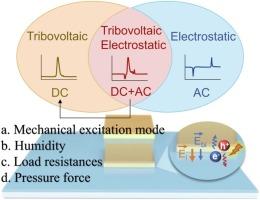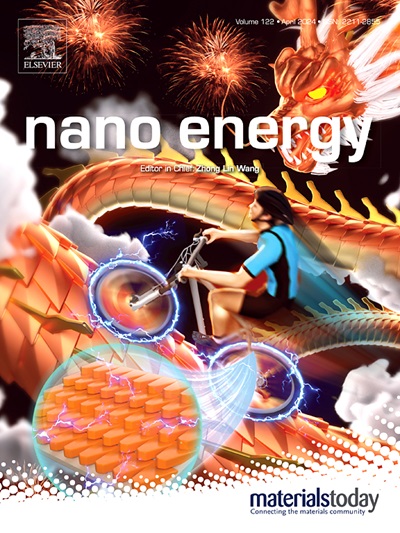动态半导体异质结界面上的摩擦光伏效应和三静电效应耦合
IF 16.8
1区 材料科学
Q1 CHEMISTRY, PHYSICAL
引用次数: 0
摘要
半导体动态界面上的摩擦光伏效应对开发各种功能器件具有重要的基础和现实意义,然而,它可以与一系列不同的物理效应耦合,如接触电化诱导的静电效应和机械磨损效应,其耦合机制仍有待阐明。在此,我们研究了两种宽带隙半导体动态异质结的摩擦光伏效应和摩擦静电效应之间的耦合:氧化锌(ZnO)和氮化镓(GaN)。研究发现,在接触分离模式下,摩擦光伏效应产生的直流输出与摩擦静电效应产生的交流输出可以明显区分开来。然后,湿度、外部负载电阻和压力揭示了这两种效应的耦合特性,即摩擦光伏效应输出受湿度影响较小,匹配阻抗较小,对高压更敏感,与三静电效应输出不同。最后,我们证明在接触分离模式下可以抑制机械磨损效应,实现超过 50,000 次循环的长期稳定性。因此,这项研究有助于深入了解摩擦光伏效应的机理,并为开发高性能摩擦光伏器件提供实际指导。本文章由计算机程序翻译,如有差异,请以英文原文为准。

Coupling of tribovoltaic effect and tribo-electrostatic effect at dynamic semiconductor heterojunction interfaces
Tribovoltaic effect at the dynamic semiconductor interface is of great fundamental and practical importance for developing a variety of functional devices; yet, it can be coupled with a series of different physical effects, such as the contact-electrification induced electrostatic effect and mechanical wearing effect, and the coupling mechanisms are still remained to be elucidated. Herein, we investigated the coupling between tribovoltaic and tribo-electrostatic effects at the dynamic heterojunctions of two wide-bandgap semiconductors: zinc oxide (ZnO) and gallium nitride (GaN). It is found that, in the contact-separation mode, the direct-current outputs from tribovoltaic effect can be clearly distinguished from the alternating-current outputs from tribo-electrostatic effect. Then, humidity, external load resistance and pressure force are found to reveal the coupling characteristics of these two effects, that tribovoltaic outputs are less affected by humidity, show smaller matched impedance and are more sensitive to high pressure force, diverging from the tribo-electrostatic outputs. Lastly, we demonstrate that the mechanical wearing effect can be inhibited in contact-separation mode, achieving long-term stability over 50,000 cycles. Therefore, this work provides insights to the mechanism of tribovoltaic effects and practical guidance for high-performances tribovoltaic devices.
求助全文
通过发布文献求助,成功后即可免费获取论文全文。
去求助
来源期刊

Nano Energy
CHEMISTRY, PHYSICAL-NANOSCIENCE & NANOTECHNOLOGY
CiteScore
30.30
自引率
7.40%
发文量
1207
审稿时长
23 days
期刊介绍:
Nano Energy is a multidisciplinary, rapid-publication forum of original peer-reviewed contributions on the science and engineering of nanomaterials and nanodevices used in all forms of energy harvesting, conversion, storage, utilization and policy. Through its mixture of articles, reviews, communications, research news, and information on key developments, Nano Energy provides a comprehensive coverage of this exciting and dynamic field which joins nanoscience and nanotechnology with energy science. The journal is relevant to all those who are interested in nanomaterials solutions to the energy problem.
Nano Energy publishes original experimental and theoretical research on all aspects of energy-related research which utilizes nanomaterials and nanotechnology. Manuscripts of four types are considered: review articles which inform readers of the latest research and advances in energy science; rapid communications which feature exciting research breakthroughs in the field; full-length articles which report comprehensive research developments; and news and opinions which comment on topical issues or express views on the developments in related fields.
 求助内容:
求助内容: 应助结果提醒方式:
应助结果提醒方式:


